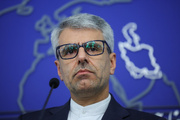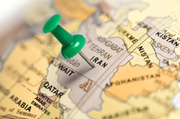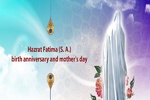September 9 marks the national commemoration day of a prominent Iranian writer, thinker and social and political critic, Jalal Al-e Ahmad. Here in Iran, he is mostly known for his critical essay Gharbzadegi (Occidentosis), translated to English as Weststruckness and Westoxification which is a cultural critique of Westernization in Iran which he called a plague. Al-e Ahamd’s "stinging critique of western technology and civilization” and his argument that the decline of traditional Iranian industries such as carpet-weaving were the beginning of Western "economic and existential victories over the East" was widely embraced by Ayatollah Khomeini and later became part of the ideology of the 1979 Iranian Revolution which emphasized nationalization of industry, independence in all areas of life from both the Soviet and the Western world, and "self-sufficiency" in economy.
The approaching of time of Hajj and Eid al-Adha (the Feast of Sacrifice), which marks the culmination of the annual Hajj pilgrimage and is considered as one of the most important religious holidays in Islam (to be celebrated this year on Sep. 22) and the commemoration day of Jalal Al-e Ahmad on Sep. 9 created the perfect opportunity to talk about one of Al-e Ahmad’s slightly less known but just as brilliantly-written as his other books, ‘A Straw in Mecca’ that chronicles his Hajj pilgrimage at the age of 41.
‘A Straw in Mecca’ or literally translated as ‘A Straw in Miqat’ which refers to the stations at which pilgrims on the Hajj put on the pilgrim's garment and perform the Hajj rituals, is one of the most notable contemporary Hajj travelogues. The book which could as well be regarded as a new chapter in the life of its author, gives a fully-detailed account of the pilgrimage and the pilgrims from various countries and all walks of life, each with their own unique customs, clothes and personality and cultural traits.
Al-e Ahmad brings some of the points he had made earlier in Gharbzadegi into his travelogue as he witnesses the discrimination and contempt leveled at the Iranian pilgrims. His travel to Mecca becomes more of a spiritual journey to find himself than to find God, as he had said God can be found everywhere for whoever that believes in him.
In one section of the book, we read:
“I looked deep into myself until dawn and realized that it was only a ‘straw’ that had come to ‘Miqat’ and not a ‘person’ to a ‘tryst’. And I saw that ‘time’ was eternal, the ocean of time. And ‘Miqat’ could be any moment and any place. And alone with oneself. For a ‘tryst’ is where you meet with another person but ‘Miqat’ is the very time of meeting and being alone with ‘oneself’.”
And somewhere else he writes in a beautiful and poetic language:
“Alas! I am not the eagle of the heavens. I cannot be the butterfly around the candle of the Sun. I am but a pull towards the sky, a gravitation toward the light. I am, however, raised on the soil; I am the child of the Earth.”
‘A Straw in Mecca’ is not a simple travelogue of a pilgrim’s visit to Mecca and his descriptions of Hajj rituals. It is rather a sharp and rushed writing on Hajj pilgrims and consists of descriptions of the author’s inner motive for the pilgrimage and a tendency toward discovering the spiritual power in himself; it is a parallel narrative of an inward and outward journey, an enthusiasm to meet new people and anticipation about their destinies; the people who embark on a journey toward the House of God and gather around Kaaba from all corners of the world and after finishing the religious rituals, return to their own countries. Al-e Ahmad wonders if the faith of these people is genuine. Have they come all this way to discover a truth? Or are they here for a vague and naive reason? Will they be returning home without actually seeing their God? Have this dense mass of people truly understood the philosophy of Hajj, this great Islamic assembly? Al-e Ahmad attempts to answer these questions and depicts his restlessness and outward experiences.
The Life of the Author
Jalal Al-e Ahmad was born on 2 December 1923 into a family of strong religious traditions originally from the village of Aurazan in the Taliqan district bordering Mazandaran in northern Iran. One year after obtaining his high school diploma in 1943, shortly after World War II, he made a complete break with religion by joining the Toudeh Party, the most powerful Marxist organization in Iran. But he soon left the party due to its pro-Soviet support for Soviet demands for oil concession and occupation of Iranian Azerbaijan. Al-e Ahmad's career as a teacher and, more importantly, as a writer of fiction also began in the immediate postwar period. Today, he is known as the writer of some 19 novels, short story collections and articles, 6 travelogues and many translations of various French writers such as Albert Camus, Jean Paul Sartre and Andre Gide. Al-e Ahmad then discovered the disease of gharbzadagi, "occidentosis" which gave him the title and idea for his best-known and most influential book. Hamid Algar, the translator of Al-e Ahmad’s short story collection Occidentosis: A Plague From the West writes in the introduction of the book that “after the publication of Gharbzadagi, almost all that he wrote was dominated by an awareness of the historical and contemporary opposition of the West and the Islamic world, by a concern for the rescue of an Iranian cultural authenticity and autonomy at the heart of which lay Shia Islam, and by a critical stance toward those of his fellow intellectuals who were carriers of the disease of occidentosis.”
In 1950, he married Simin Daneshvar, a well-known Persian novelist best known for her novel Suvashun ('Mourners of Siyavash', also known as A Persian Requiem,1969), which is considered to be first novel by an Iranian woman and went on to become a bestseller. In the remaining years of his life, Al-e Ahmad accomplished two other important pieces of work: the novel, Nafrin-e Zamin (The curse of the land), published in 1967, which is a depiction of the disruptions wrought in the Iranian countryside by the so-called Land Reform, and Dar Khedmat va Khiyanat-e Roushanfekran (Concerning the service and disservice of the intellectuals).
Jalal Al-e Ahmad died on September 9, 1969, in a village in Gilan, weakened by years of constant strain. He was buried near the Firuzabadi mosque at Shahr-e Ray, to the south of Tehran.
























Your Comment